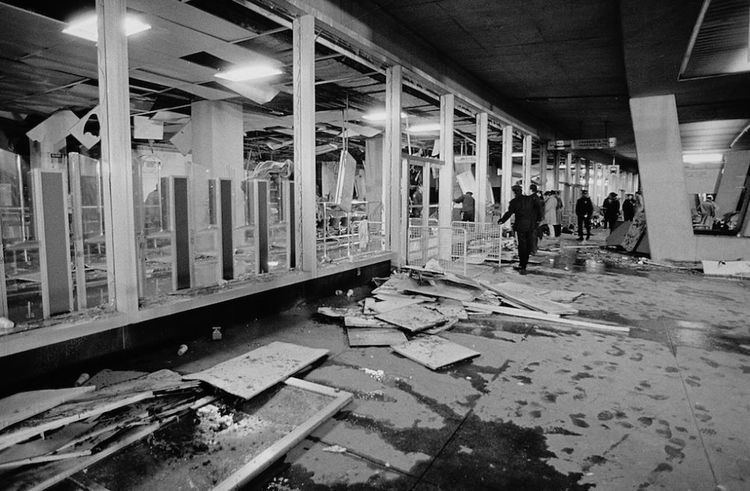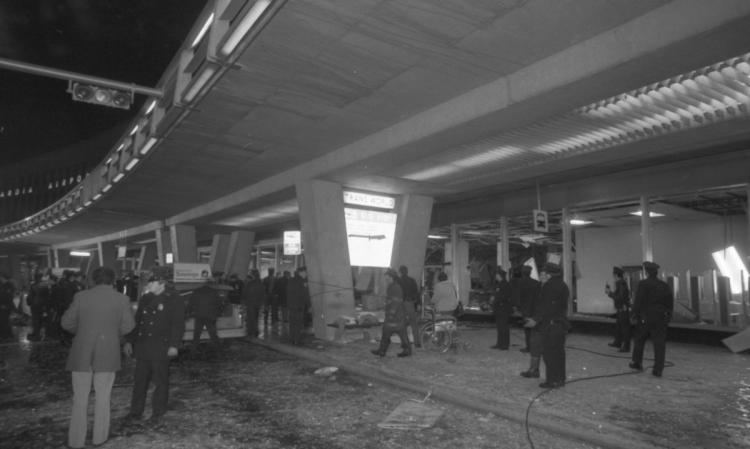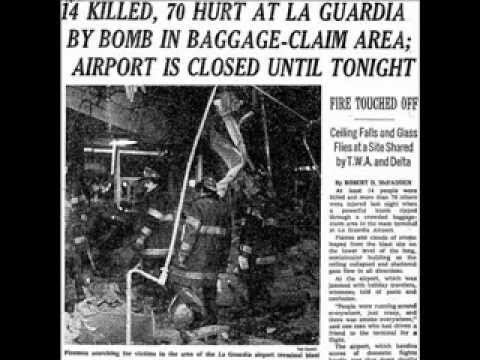Target La Guardia Airport Perpetrators Unknown Start date December 29, 1975 | Non-fatal injuries 74 Motive Unknown Total number of deaths 11 Attack types Bomb, Mass murder | |
 | ||
Similar Wall Street bombing, 1983 United States Se, 1997 Empire State Buil, Los Angeles Jewish C, 2002 Los Angeles Internatio | ||
The 1975 LaGuardia Airport bombing occurred at 6:33 pm on Monday, December 29, 1975, near the TWA baggage reclaim terminal in LaGuardia Airport in East Elmhurst, New York City. The blast killed 11 and seriously injured 74. The bombing was never solved, with several suggested perpetrators, although investigators and historians believe that Croatian nationalists were the most likely. The attack occurred in a four-year period of heightened terrorist attacks within the United States. 1975 was especially volatile, with bombings in New York City and Washington D.C. early that year and two assassination attempts on US President Gerald Ford.
Contents

The LaGuardia Airport bomb, at the time, was the single most deadly attack by a non-state actor to occur on American soil since the Bath School bombings, which killed 44 people in 1927. It was the deadliest attack in New York City since the Wall Street bombing of 1920, which killed 38, until the terrorist attacks on the World Trade Center in 2001.

Attack

The bomb exploded at approximately 6:33 pm on December 29 in the TWA baggage claim area in the central terminal. The equivalent of 25 sticks of dynamite was believed by investigators to have been placed in a coin-operated locker located next to the carousels in the baggage reclaim area. The bomb blew the lockers apart, causing shrapnel to fly across the room; the shrapnel was responsible for all 11 deaths and injuring several others. Others were injured by shards of glass broken off the terminal's plate glass windows. The force of the bomb ripped a 10 foot by 15 foot hole in the 8-inch reinforced concrete ceiling of the baggage reclaim area. The subsequent fire in the terminal took over an hour to get under control.

The death toll could have been much worse if the area had not been largely clear of passengers at the time; two flights from Cincinnati and Indianapolis had arrived about 6.00pm and most of the passengers on these flights had already left the area. Most of the dead and injured were airport employees, people waiting for transportation, and limo drivers.
Aftermath

One witness, H. Patrick Callahan, a 27-year-old lawyer from Indianapolis, was with his law partner at the time of the bombing. "My law partner and I had gone outside to see where the limo was...We had just gone back and we were leaning against one of those big columns. The people who died were standing next to us." said Callahan. When Callahan awakened all he could see was dust, and he could not even see his companion, who was two feet away at the time. The blast damaged Callahan's hearing, which did not return for a week. "The bomb appeared to have been placed in the lockers directly adjacent to the carousel that the luggage was on...It was evil." said Callahan.

The bombing was condemned by Pope Paul VI and President Ford, who said that he was "deeply grieved at the loss of life and injuries." Ford cut short his vacation in Vail, Colorado and ordered John McLucas, head of the FAA, to look into ways of tightening airport security. The Mayor of New York City Abraham Beame said that the bombing "was the work of maniacs. We will hunt them down."
Airports in Washington, Cleveland and St, Louis were evacuated following hoax bomb calls and several other airports around the country received similar calls.
Investigations
The investigation was led by Queens Chief of Detectives Edwin Dreher. Dreher was less than two miles from LaGuardia, investigating a drug-related murder in the neighborhood of Astoria, when he heard of the bombing. He immediately went to the airport and summoned by radio all available detectives from the five boroughs, launching at the time the largest criminal investigation in the NYPD's history. The investigation included 120 NYPD detectives, 600 FBI agents, ATF agents and Port Authority investigators, who concluded that the bomb was made of either TNT or plastic explosives and was controlled by everyday household items such as a Westclox alarm clock and an Eveready 6-volt lantern battery. One of the leads suggested was a paroled political activist who had been imprisoned for a previous bombing. The activist's brother had been arrested at LaGuardia on a fraud charge the day before the bombing. Subsequent investigations showed that the activist had an alibi and was ruled out as a suspect.
The investigation may have been hampered by the cleanup operation where victims and debris was removed from the scene.
Following the attack, telephone calls were made to several other US airports warning them of further attacks, but these were hoaxes. In addition, an anonymous caller rang the news agency UPI claiming to be from the PLO and claimed responsibility for the attack. However the PLO spokesman at the United Nations denied all responsibility and condemned "the dastardly attack against the innocent people at LaGuardia." The PLO believed the call linking it to the bombing was an attempt to sabotage talks at the UN scheduled for January 12 regarding the plight of Palestinians.
Other suggested groups included the Mafia, the F.A.L.N. (who were responsible for the bombing of New York's Fraunces Tavern in January 1975), and the Jewish Defense League, though there was nothing other than the fact that these groups had used violence in the past which could link them to the bombing.
The fact that there was no credible claim of responsibility led investigators to believe that the bomb had gone off at the wrong time and had been intended to go off either 12 hours earlier or later when the area would have been nearly clear of people. A final possibility suggested by experts in the intelligence field is that the FBI and the Yugoslav State Security Administration (UDBA or UDSA) orchestrated the bombing in a false flag attempt to discredit Croatian dissidents, but the device failed and the bomb detonated at the wrong time.
The Air Transport Association offered a $50,000 reward for information leading to the arrest of the bombers. Despite this the investigation was fruitless.
As of 2016, the crime remains officially unsolved.
1976 Grand Central Terminal bomb
On September 10, 1976, a group of Croatian nationalists led by Zvonko Bušić, his wife Julienne and two others hijacked TWA Flight 355 from LaGuardia to Chicago. Bušić delivered a note to the captain in which he informed him that the airplane was hijacked, the group had five gelignite bombs on board, and another bomb was planted in a locker in Grand Central Terminal in New York with further instructions. During the hijacking the device at Grand Central Terminal was found and taken to Rodman's Neck Firing Range where police attempted to dismantle it rather than detonate it. After setting a cutting instrument on the two wires attached to the device, the officers retreated from the pit for several minutes. They then returned to the pit to continue dismantling the device when it exploded and killed an officer, Brian Murray. Bušić and his accomplices were arrested when the plane arrived in Paris. Bušić was subsequently sentenced to life imprisonment but was eventually paroled. The similarities between the Grand Central bomb and the LaGuardia bomb led personnel involved in the investigation to believe that Bušić was responsible for the bombing or at least had some involvement. However no charges for the crime were ever brought forward and Bušić vigorously denied any involvement. Speaking after his release in 2008, Bušić said “to this day, have absolutely no knowledge about who did it" and "It is inconceivable to me that I would have been granted parole if there was any evidence linking me to that horrible crime." FBI officials also contacted the U.S. Parole Commission in September, 1997, in regard to Zvonko Busic's alleged involvement in the unresolved La Guardia case, stating that "the La Guardia case remains a mystery, but there is no evidence that Busic was involved in that incident. To deny his parole with the taint of the case is unjustified and I will personally attest, if called upon, that he would pose no future threat to society."
